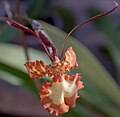| Butterfly orchid | |
|---|---|
 | |
| Psychopsis papilio In situ in Trinidad | |
| Scientific classification | |
| Kingdom: | Plantae |
| Clade: | Tracheophytes |
| Clade: | Angiosperms |
| Clade: | Monocots |
| Order: | Asparagales |
| Family: | Orchidaceae |
| Subfamily: | Epidendroideae |
| Tribe: | Cymbidieae |
| Subtribe: | Oncidiinae |
| Genus: | Psychopsis Raf. |
| Type species | |
| Psychopsis papilio | |
| Synonyms [1] | |
| |

Psychopsis is a genus of four known species of orchids native to northern South America, Central America and Trinidad. [1] [2] The genus name is abbreviated Pyp. in the horticultural trade. [3]



